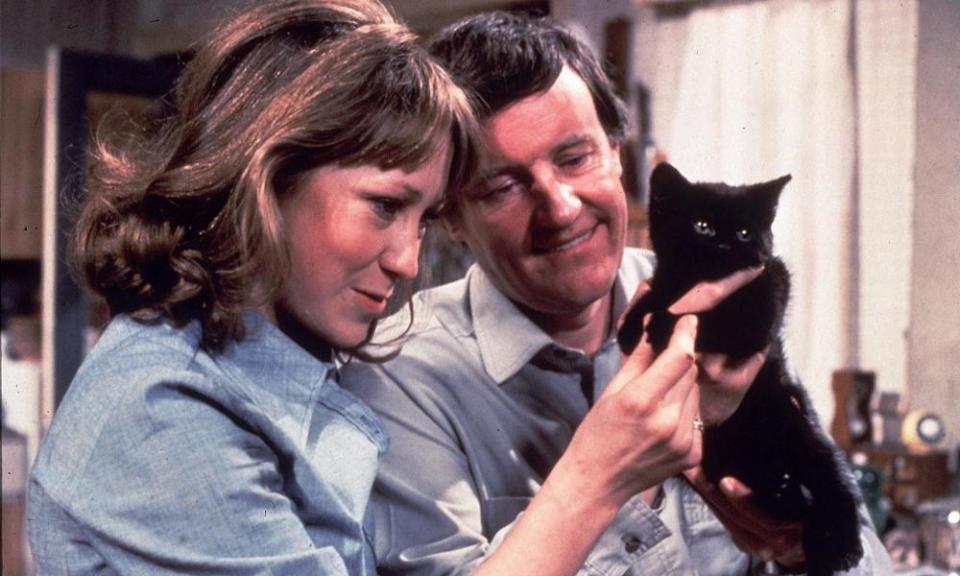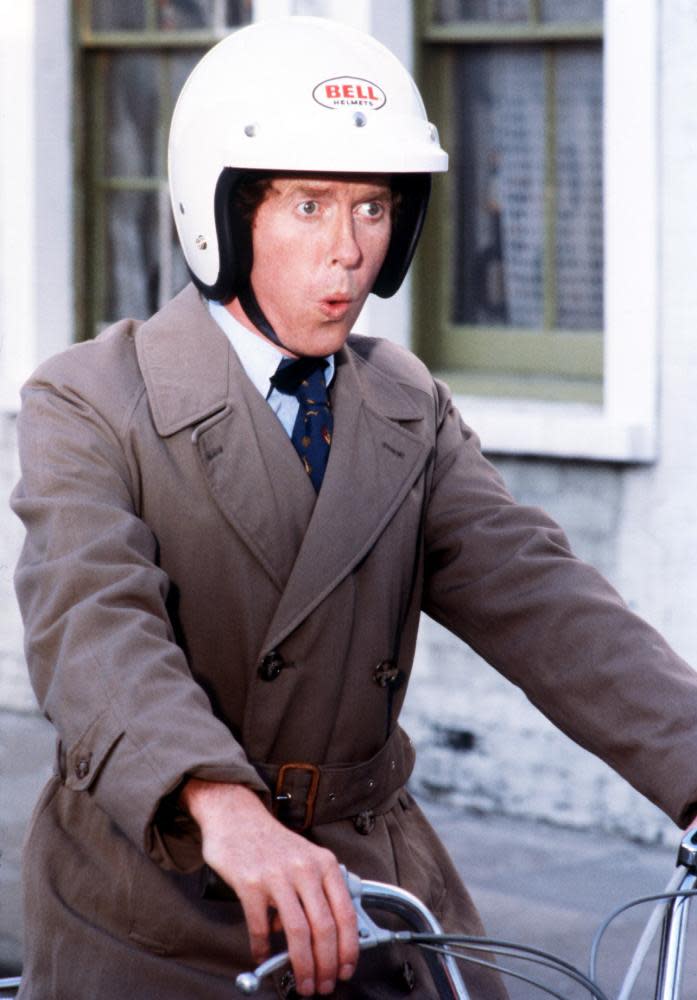Lovely jubbly! How theatre tuned into classic TV sitcoms

During the social confinements caused by coronavirus, many theatre-goers will be relying on television for entertainment. However, when the stages eventually reopen, a lot of audiences will, paradoxically, still find themselves watching TV.
While movies have long been a source of theatrical material, old TV series have started to rival them as inspiration for adaptations. Among the most anticipated of the stage productions currently furloughed is a recycling (appropriately) of The Good Life, the 70s BBC sitcom about a suburban couple who adopted a green lifestyle decades before it became fashionable.
Theatre shows currently suspended include a UK tour of the sitcom Some Mothers Do ’Ave ’Em and a musical version of Only Fools and Horses. Longer term, a musical of The Fall and Rise of Reginald Perrin is in preparation at Birmingham Rep.
Why has theatre become so drawn to classic sitcoms? Jeremy Sams, adapter-director of The Good Life stage remake, says: “There can be a pragmatic reason. The reason they’ve put on Pretty Woman: The Musical, for example, is that the people who went to see the original movie are now rich enough to pay West End theatre prices.”
Viewers of 70s sitcoms may similarly have economically matured. But a major creative motivation is that TV sitcoms and stage comedies are close artistic siblings. Most scenes in the original shows were performed in big auditorium studios, in front of hundreds who had applied for tickets. Another recent TV-theatre transfer, The Upstart Crow, though screened much more recently, was specifically made to a 70s live-audience template.
“The rules of stage comedy,” says Sams, “are very similar to those of sitcom, in terms of settings and numbers of characters.”
Although often assumed to be a canned laughter track, British studio audience laughter was usually real, though sometimes electronically enhanced. So, to maximise audible reaction, episodes were often structured like a stage farce. Some Mothers Do ’Ave ’Em, in which Michael Crawford played the accident-prone and unemployable Frank Spencer, specialised in spectacular stunts, with the character tumbling down stairs or his house falling down around him.
As a result, Guy Unsworth, who adapted and directed the stage version, feels that he is bringing stage-farce conventions back home. “I think the live studio audience was absolutely key because it gives these scripts a theatrical energy. TV is often shot very safely in many takes. But the stunts had a real sense of danger, because they were designed to make the studio audience gasp. So I was fascinated by doing those in theatre.”

The estates of the writers of The Good Life, John Esmonde and Bob Larbey, allowed Sams to use any material he wanted from the 30 broadcast episodes.
“I sat down to construct it as a play,” he says, “but it seems to be in the DNA of sitcom that it falls into half-hour chunks. So I effectively now have four half-hour acts, with an interval after two, that lead into each other and form a single story.”
He has substantially redeployed three episodes from the series – including those in which Tom and Barbara first decide to go green, a baby pig is born and Margot sings in an amateur production of The Sound of Music – and shaped a storyline of his own around two dinner parties.
In the case of Some Mothers Do ’Ave ’Em, the TV writer Raymond Allen, 80 this month, was available to be involved in the stage version, but chose not to be. “He was really keen on the idea,” says Unsworth, “but didn’t know how to make it work on stage. So he has been incredibly supportive but also trusted me to do it.”
From the 23 available episodes, Unsworth has framed a play around an episode in which Frank discovers that he is going to be a father, and a Christmas special in which the BBC comes to audition Frank for a TV talent show. At the performance I saw, the show was regularly stopped by laughter or applause at the crossed-purpose dialogue, a signature of the TV show, in which, for up to 15 minutes, some characters think “it” refers to one thing (often sex) while the rest of the cast and the audience are aware of the real definition. As when the local priest fears he is being told elaborate details of the night of the Spencer baby’s conception, rather than an account of domestic renovations.

“I found the sequences of misunderstanding really interesting,” says Unsworth. “What a character falsely thinks ‘it’ to be can be really quite daring and out there, because the audience knows that the real explanation is completely innocent, so it somehow makes it OK.”
However, because TV peak-time of the past was significantly less sensitive to stereotype and offence than is contemporary culture, I was interested in how much of the source material had proved unspeakable now? Some Mothers, says Unsworth, didn’t really have ’em. “I went through every single episode, and maybe there are a couple of lines that might be a bit iffy now. But, considering that vintage of sitcom, and how really dodgy many of them are, Some Mothers exists in quite an innocent world.”
Sams was startled by the casual homophobia of The Good Life on TV: “Someone will cock a wrist to suggest that someone might be gay, in a way I have never seen any gay person do ever. And there is a tight-fisted restaurateur in one episode who can be seen as an offensive Jewish stereotype. That sort of stuff passed without notice in those days. It was part of the weather. So I’ve cut those.”
In performance, a crucial question is whether the performers are giving their own interpretation of the character, or an impersonation of the original TV actor. In a recent one-off TV revival of Are You Being Served?, for example, no one seemed to have decided if the new cast was playing John Inman or his character Mr Humphries, Mollie Sugden or Mrs Slocombe.
“People have actually asked me, ‘Who’s playing Felicity Kendal?’, or ‘Who’s playing Penelope Keith?,” says Sams. “It can’t be like that.”
Related: Katherine Parkinson: ‘Felicity Kendal’s wellies are big ones to fill’
He has cast Katherine Parkinson as Barbara, with further casting to be announced soon. “In auditions, there were actors who didn’t know the TV show, and so just treated it as the script for a new play. And that was fantastic. Because that’s what I’m aiming for.”
Unsworth says that he and his lead actor, Joe Pasquale, “worked on that issue from the very beginning. Michael Crawford was absolutely amazing on screen. But I felt Joe had to be someone very different. I was saying all the time, ‘Play him as a character.’ If you are spending two hours with someone on stage, you have to believe in them as human beings. And an impression, however skilled, wouldn’t be as good as the original.”
Raymond Allen has given the live Frank Spencer an active recommendation (“He’s seen it 16 times,” says Unsworth. “He’s thrilled by it”) and the Esmonde and Larbey estates have enthusiastically approved Sams’ adaptation.
Preparing his production, Sams is most exercised by staging the menagerie that the Goods assemble to achieve self-sufficiency. Will they be animatronic animals? “I’ve written a part for a goat, which is very important. At the moment, I’m trying to work out how to do it without a real one. Partly because a goat ends up costing more than a performer, once you pay for the goat wrangler and the goat dressing room, and so on.”


